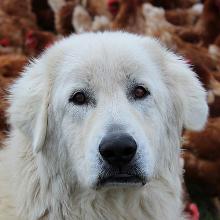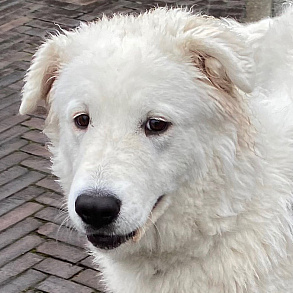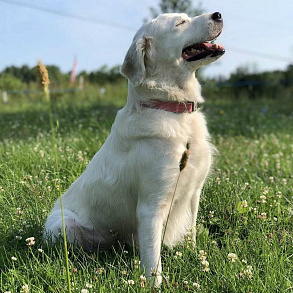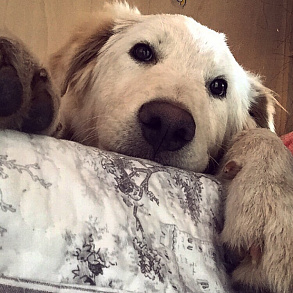Maremma-Abruzzi Shepherd

Maremma-Abruzzi Shepherd (Maremma) is an Italian breed of large white dogs bred specifically for the protection and driving of sheep. All individuals are distinguished by an innate distrust of strangers, as well as the ability to independently analyze the situation and make decisions.
Brief information
- Breed name: Maremma-Abruzzi Shepherd
- Country of Origin: Italy
- Weight: males 35-35 kg, females 30-40 kg
- Height (height at the withers): males 65-73 cm, females 60-68 cm
- Life expectancy: 11-14 years
Highlights
- The breed is considered rare and is not widespread everywhere. Most of all, maremma is appreciated by farmers in Italy, the USA, Australia and Canada.
- The independent nature of animals is the result of many years of working breeding with minimal communication with humans.
- In Australia, since 2006, Maremma-Abruzzi shepherds have been attracted to the protection of the population of blue penguins and wombats.
- You should not start a maremma if your house is constantly open to big noisy companies and new acquaintances. Representatives of this family do not favor outsiders, taking them as a potential threat.
- Shepherds are not hyperactive and do not need intense sports loads, but it is difficult for them to adapt to life in an apartment.
- The breed is not created for official work and complete subordination: Maremma-Abruzzi Shepherds perceive the owner as an equal companion, whose opinion is not always worth listening to.
- Maremm has a very developed craving for "guardianship" activities, therefore, in the absence of sheep, the dog guards children, poultry and even small decorative pets.
- The snow-white coat of the Maremma-Abruzzi Shepherd almost does not smell like a dog, even if it is wet. The exception is unkempt, sickly individuals.
- There are from 6 to 9 puppies in the maremma litter.
Maremma-Abruzzi Shepherd is a responsible guardian and defender who easily gets along with any representatives of the fauna, but is extremely distrustful of two-legged strangers who set foot on his territory. Only children can melt the ice in Maremma's heart, whom she willingly trusts, forgiving the most annoying pranks. These harsh "blondes" also build relationships with the owner not according to the classic scenario for shepherds. The owner of the dog is a friend and companion, but by no means an object of worship, whose demands must be fulfilled with lightning speed. Additional fame for the breed was brought by the family film "The Weirdo" (2015).
Breed characteristics
History of the Maremma breed-Abruzzi Shepherd
The Maremma-Abruzzo Shepherd got its name thanks to two historical regions of Italy – Maremma and Abruzzo. For a long time, the regions have been arguing among themselves for the right to be considered the homeland of dogs. But since the conflict dragged on, and there was no preponderance in any of the parties, the dog handlers had to compromise and enter both areas into the name of the breed. As for the first mentions of white-haired sheepdogs-giants, they are easy to find in the works of ancient Roman authors Rutilius Palladius and Lucius Columella. Describing the peculiarities of farming in the territories of the Eternal City, both researchers noted white dogs that deftly manage the grazing and overtaking of sheep.
Sculptures and frescoes depicting the first Maremm have also been preserved. You can evaluate the appearance of the ancestors of today's sheepdogs at the Archaeological Museum of Capua, the British Museum (look for a figure with the name Jennings' Dog/The Dog of Duncombe), the Church of Santa Maria de Novella in Florence, as well as the Church of San Francesco in Amatrice. If you happen to visit an exhibition of paintings from the Vatican Pinacoteca, be sure to find the painting "Christmas" by the medieval painter Mariotto di Nardo – Maremmo-the Abruzzi shepherd is depicted very realistically on it.
The breed was registered in the stud books in 1898 – at the time of the procedure, documents were issued to only 4 individuals. In 1924, the animals received their first appearance standard, compiled by Giuseppe Solaro and Luigi Groppi, but in the future, until 1940, shepherds were no longer involved in registration. It is worth paying attention to the fact that until the middle of the XX century, dogs from Maremma and dogs from Abruzzo were positioned as two independent breeds. This was explained by the fact that historically individuals from these regions very rarely contacted each other, developing in isolation. The mixing of phenotypes occurred only during the cattle drive through the country – sheepdogs accompanied sheep, entered into communication with dogs from other areas and bred mixed-breed puppies along the way. The unification of the breed clans into one family called the Maremma-Abruzzi Shepherd Dog occurred only in 1958, at the insistence of the same Giuseppe Solaro.
Video: Maremma-Abruzzi Shepherd
Maremma breed standard-Abruzzi Shepherd
Maremma is a solid, but by no means overweight "blond", inspiring respect with his impressive noble appearance. External nervousness and feigned suspicion are not inherent in the breed, therefore, the expression of the muzzle in shepherds is more concentrated and attentive than severe. The physique of the representatives of this family is moderately stretched, but at the same time balanced. Males are noticeably larger and heavier than bitches. The standard height of a thoroughbred "boy" is 65-73 cm, weight is 35-45 kg. "Girls" weigh 30-40 kg with a height of 60-68 cm .
Head
The shape of the Maremma-Abruzzi Shepherd's skull resembles a polar bear. The head itself is in the form of a cone, large, without relief outlines. Rounded cheekbones stand out well on the wide cranium. The divergence of the head line with the upper line of the muzzle is noticeable, forming a convex profile pattern. The occipital protuberance and brow arches are clearly marked. The frontal furrow, on the contrary, is strongly smoothed. The stop is implicit. The muzzle is about ⅒ shorter than the skull.
Jaws, lips, teeth
Impressive jaws with massive, evenly set incisors. Teeth are white, healthy, forming a proper bite in the bow-scissors. The lips of the Maremma-Abruzzi Shepherd are devoid of the fleshiness characteristic of many large breeds, so they barely cover their teeth. As a result: if you examine an animal with a closed mouth in profile, only the angular part of the lips, colored in a rich black tone, will be noticeable.
Eyes
With more than impressive dimensions, maremma has small eyes. The shade of the iris is usually ochre or chestnut-blue. The eyeballs themselves do not differ in bulge, but a deep fit is also not typical for them. The black-bordered eyelids have an elegant almond-shaped incision. The look of the breed is intelligent, insightful.
Ears
The Maremma-Abruzzi Shepherd's ear cloth is characterized by excellent mobility and hanging position. The landing of the ears is above the cheekbones, that is, very high. The size of the ear cloth is small, the shape is v-shaped, with a pointed tip. The length of the ear does not exceed 12 cm. An important caveat: today's maremma ears are not stopped. The exception is individuals who continue to perform pastoral service.
Nose
A large black lobe with wide nostrils should not extend beyond the front edges of the lips.
Neck
A purebred Shepherd dog's neck is always ⅕ shorter than its head. The neck itself is thick, without suspension, remarkably muscled and forming an arc-like bend in the upper part. This part of the body is pubescent very profusely, as a result of which the wool forms a rich collar closer to the chest.
Housing
The body is strong, slightly elongated. The rounded, tapering chest descends to the elbow joints. The back on the segment from the wide, raised withers to the croup is straight, then with a slight sloping. The lumbar part is shortened and does not protrude beyond the upper dorsal line. The croup is powerful, with a good slope: the angle of inclination in the area from the base of the tail to the hip is 20 °. The bottom line is an arched type with a fitted belly.
Legs
The Shepherd's hind and front legs are in balance with the body and have an almost straight delivery. The scapular areas have developed muscle mass and elongated contours, the shoulders are at an angle of 50-60 ° and are pressed closely to the sides. The forearms are longer than the shoulders and are located almost vertically, the metacarpal joints are thickened, with a clearly defined projection of the pea-shaped bones, the size of the pastern is necessarily ⅙ the length of the front leg.
In the Maremma-Abruzzi Shepherd, the hips are located at an angle (orientation from top to bottom). The lower leg is shorter than the femur, but with a powerful bone and dry musculature. The joints of the hocks are thick and wide. The metatarsals are strong, dry type, necessarily without dewclaws. The dog's paws are rounded, the fingers are closed, the claws are black. A less preferred option is chestnut claws.
Tail
Since the Maremma-Abruzzi Shepherd's croup is characterized by a strong slope, the base of the dog's tail has a low fit. At rest, the tip of the tail hangs below the level of the hocks. In a moving shepherd, the tail is raised no higher than the upper part of the back, while the tip is noticeably curved.
Wool
Maremma's dogskin resembles a horse's mane. The hair is long (up to 8 cm), rather hard, abundant and uniform on all parts of the body. It is desirable to have a collar on the chest and feathering on the hind legs. Light undulation of the coat is also not considered a defect. The hair on the head, muzzle, front paws and ears is very short. In winter, a thick undercoat grows on the body, which disappears by summer.
Color
The ideal maremma is a dog with snow–white fur. It is undesirable, but it is permissible to have areas on the body that are colored in the tone of ivory, or in light red and yellowish-lemon colors.
Disqualifying vices
- Pigmented nose.
- Aggression. Unreasonable cowardice.
- The muzzle is convex or concave type.
- Pronounced jaw overbite.
- Strabismus, irregularly colored iris, eyelids without pigment.
- Short or completely absent tail.
- Curly hair.
- Solid isabella color, as well as the presence of spots of this shade and black hairs.
The character of the Maremma-Abruzzi Shepherd
Do not confuse the security activities of the maremm with the working equipment of the wolfhound. Historically, the breed was bred to scare away enemies from the herd – there was never any talk of engaging in a fight with predators and thieves who decided to eat free lamb. Usually the dogs worked as a group: each participant of the action had his own observation post, which helped to repel the enemy's attack in a timely manner. Modern Maremma-Abruzzi Shepherds have preserved the guard instincts of their ancestors, which could not but leave an imprint on their character.
All representatives of today's maremm family are serious and proud creatures who periodically have problems with subordination. It cannot be said that these "Italians" are the most difficult–to-educate shepherds, just unconditional submission is not their strong suit. The dog considers the person in general and the owner in particular to be equal to himself, therefore, all attempts to "suppress" the animal with his authority can be considered obviously a failure.
The Maremma-Abruzzi Shepherds are condescending only to children, patiently enduring their stroking and suffocating hugs. However, such benevolence does not apply to unfamiliar kids, so if you are visited by friends with a not particularly well–mannered child, it is better to isolate the dog - maremma can react to the leprosy of someone else's offspring in an unexpected way.
The breed has a pretty good memory, supported by selectivity in communication. Usually the dog peacefully greets guests who have previously appeared on the doorstep of the house and are remembered for their exemplary behavior. Strangers and family friends who previously provoked a pet to a conflict, the animal suspects of all mortal sins and scans with an emphatically hostile gaze.
Maremm has no hunting habits as such, so the breed is not dangerous for other pets. Moreover, living side by side with other representatives of the fauna awakens ancient instincts in the shepherd. As a result, maremma begins to "graze" chickens, ducks, cows, and in general any living creatures up to penguins.
Education and training
Maremm's slight detachment of behavior and unwillingness to blindly follow the owner were formed intentionally. Historically, contact between the puppy and the owner was minimized, and individuals who were friends with a person were often rejected. At a month and a half, maremm was already planted in a pen with sheep so that they would learn to protect their "flock" and wean themselves from communicating with the owner. This helped to raise responsible defenders capable of making independent decisions from shepherds, but not the most obedient servants.
There is an opinion that Maremma-Abruzzi shepherds, in principle, are not aimed at memorizing commands, so if the pet manages to develop adequate behavior to the requirements of "To me!" and "Sit!", this is already a great achievement. In fact, it's not so sad. Yes, maremmas are not service workers and, when faced with the choice of guarding the territory or rushing after a stick thrown by the owner, they will always choose the first option. Nevertheless, it is realistic to train them. In particular, with a six-month-old puppy, you can easily take an OKD course. The training methodology is used the same as for all shepherds – Maremma does not need exceptions and indulgences.
A very important nuance is punishment. No physical impact should be exerted, no matter how the puppy provokes. And the point here is not in the subtle mental organization of the dog. It's just that the Maremma-Abruzzi Shepherd will never forgive you for a blow and will cease to recognize your authority after the first execution. The most difficult period in the life of every maremma dog owner is the age of 7-9 months. This is the period of puberty, when the puppy grows up and begins to encroach on the title of the main one in the house.
The grown-up bully will have to be treated more strictly, but without assault. A short leash is effective for disciplining a pet. Training at this time is not canceled, but is carried out in a standard mode, but with stricter requirements. Another "cure" for disobedience is a demonstration of physical superiority. This approach is used only in a situation where the dog calls the owner to an open confrontation. Usually, to sober up a presumptuous animal, a push in the chest (not to be confused with a blow) or a sharp jerk of the leash is enough.
In articles devoted to the training of the breed, inexperienced owners are strongly advised to resort to the services of a professional dog handler. However, do not rush to blindly follow the recommendations: the maremma pro, of course, will teach, but she will listen mainly to him, not to you. If you want to get a well-mannered and adequate dog, train it yourself, and take your pet to classes with a dog handler a couple of times a week to get useful advice and correct mistakes.
Maintenance and care
Maremma-Abruzzi Shepherd – an aviary-yard type dog. It is also possible to meet representatives of the breed who have managed to get used to living in a city apartment, but it is important to understand that in such cases animals simply adapt to the situation. We are not talking about any full-fledged life in cramped conditions.
Ideal when the pet can move freely from the house to the yard and back. Maremmas are also not created for life on a chain: such restrictions break the shepherd's psyche, turning it into an embittered and uncontrollable creature. The breed does not need intense physical exertion, but twice a day an adult dog needs to be discharged on a walk. It takes 1.5-2 hours to walk the maremma, and in any weather, so for inactive owners, a shepherd from Abruzzo is not the most suitable option.
Hygiene
The Maremma-Abruzzi Shepherd's wool is considered self-cleaning. This means that the dog is able to get dirty, but this condition will not affect its exterior dramatically. Dirt sticks to the maremmas in rainy weather, while only the dogskin gets wet, and the undercoat remains dry and clean in any case. The breed's wool does not get off into tangles, if the dog is healthy and at least minimally cared for.
Sheepdog males shed once a year, with bitches such transformations can occur more often, especially during the gestation and birth of puppies. Many breeders recommend bathing the maremma at the very beginning of molting – this accelerates the process of changing the coat. In other cases, it is better to replace bathing with a systematic dry or wet brushing – in the period between the molts of the hair of the Maremma-Abruzzi Shepherds almost does not fall out.
Puppies need to be combed more often, ideally daily. In order for the junior wool to be replaced by an adult faster, you need to purchase a pukhoderka. Maremma babies do not like this device, but with regular use they quickly get used to it. The claws of puppies are cut every two weeks, for adults – once a month. Systematic hygiene of the maremma's ears and eyes is also mandatory. Specific skills are not required for this. Dust lumps should be removed from the corners of the eyelids daily with a damp cloth, and the ears should be cleaned once a week with a napkin moistened with a special lotion.
Feeding
A natural diet is suitable for the breed, which should be based on any lean meat and offal. Heat treatment of meat is not required, since raw animal protein is more useful for shepherds. You can supplement the menu for maremma with frozen boneless sea fish, low-fat cottage cheese and curdled milk. The egg can be given no more than 1-2 times a week. Be sure to make shavings for your pet from raw fruits and vegetables – apples, pumpkins, carrots, zucchini. Such salads can be seasoned with sour cream, unrefined sunflower oil or fish oil. For porridges with meat, it is better to use buckwheat, rice and oatmeal.
There must be a bowl of water in free access, while a bowl with lunch and dinner is placed at the disposal of the pet for a strictly defined time. If the dog does not want to finish the portion, the food is removed. This approach allows you to discipline the animal and get used to the regime faster. From 1.5 to 2 months, Maremma-Abruzzi Shepherd puppies are fed six times a day. From 2 to 3 months – five times a day. By 3 months, it is recommended to reduce the number of feedings to four per day. From 4 to 7 months, maremma is fed three times a day. An 8-month-old puppy is considered an adult, so his bowl is filled with food only twice a day.
Important: do not be impressed by the impressive dimensions of the breed and do not try to increase the standard portion of food – the shepherd dog should not get fat and spread out, which will create additional problems for the joints.
Maremm Health and diseases
With proper care, Maremma-Abruzzi Sheepdogs live up to 12 years and are distinguished by good health. At the same time, the breed has an increased sensitivity to anesthetics, which complicates the conduct of many veterinary procedures, including operations. Like most large breeds, maremms also have joint problems. In particular, animals may develop hip dysplasia, diaphyseal aplasia, as well as dislocation of the patella.
How to choose a puppy
- If you do not plan to grow a working shepherd dog from maremma to protect livestock and property, look for breeders engaged in breeding exhibition and home lines of the breed. Their wards are more focused on human contact and are less suspicious of others.
- A good maremma puppy is a brave puppy! If a four-legged shaggy ball barked at you at the entrance to the nursery, you can be sure that in the future a brutal and harsh watchman will grow out of it.
- It is undesirable to take a pair of same-sex puppies: both at work and in everyday life, Maremma males and bitches get along better with representatives of the opposite sex.
- Evaluate the living conditions of puppies in the kennel: dogs should not be locked up and afraid of people. An unpleasant smell in the room where the animals live also does not characterize the breeder in the best way.
- The presence of the results of the examination for genetic dysplasia of the joints in the litter producers will be a great advantage.
- Always specify the age of the manufacturers. Keep in mind that the Maremma-Abruzzi Shepherd bitches are allowed to breed from the age of 18 months and finish their breeding "career" by the age of 8.
- Find out from the seller what is the litter of puppies for the year. Ideally, if the maremma brings offspring once every 12 months. In some cases, two litters per year are allowed – the FCI no longer registers a larger number.
Price of Maremma-Abruzzi Shepherd dog
You need to buy an animal in monopred kennels officially registered by the FCI ("Light of the Posad", "White Guardian" and others). The cost of a promising maremma puppy ranges from $350 to $500. Individuals from American breed lines are considered a good acquisition. The average cost of a Maremma-Abruzzi Shepherd dog in the USA is $ 1200-2500, and the lower price level is relevant only for pet–class animals that will not be able to participate in breeding.


